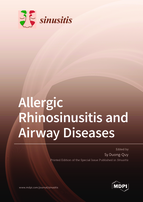Allergic Rhinosinusitis and Airway Diseases
A special issue of Sinusitis (ISSN 2673-351X).
Deadline for manuscript submissions: closed (30 September 2021) | Viewed by 45854
Special Issue Editor
2. Respiratory and Lung Functional Exploration Department, Cochin Hospital, Paris Descartes University, Paris, France
3. Bio-Medical Research Center, Lam Dong Medical College, Pham Ngoc Thach University of Medicine, Ho Chi Minh City, Vietnam
Interests: allergic rhinitis; anosmia; asthma; snoring; obstructive sleep apnea; exhaled nitric oxide; COVID-19; long COVID-19
Special Issues, Collections and Topics in MDPI journals
Special Issue Information
Dear Colleagues,
The concept of united airway disease interaction comprises allergic rhinosinusitis including allergic rhinitis, eosinophilic chronic rhinosinusitis, and other upper or lower airway disorders such as obstructive sleep apnea, bronchial hyperresponsiveness and allergic asthma. It embodies a coherent pathophysiology and a comprehensive approach to the treatment of upper and lower airway disorders. The treatment of chronic allergic rhinosinusitis may reduce obstructive sleep apnea symptoms, chronic cough, or the dose of inhaled corticosteroids necessary to treat asthma, and vice versa.
Many objectives in the interaction concept between allergic rhinosinusitis and airway disease management should be achieved in the near future for reliable control of each disease. More awareness of allergic rhinosinusitis and its comorbidity with other airway diseases must be emphasized in the patients' management programs. Progress in diagnosis, with the help of the advanced biomarkers and relevant imagery techniques associated with accurate treatment of allergic rhinosinusitis and airway diseases, should be developed by scientists to drive indication and follow-up of target treatment with biologic therapies. Finally, more research on the interaction between allergic rhinosinusitis and airway diseases considered comorbidities or modifiable cofactors should be reconsidered by physicians in the next decade.
This Special Issue, “Allergic Rhinosinusitis and Airway Diseases” is open to the publication of relevant data and ideas from clinical practice and research. The listed keywords suggest just a few of the many possibilities.
Prof. Dr. Sy Duong-Quy
Guest Editor
Manuscript Submission Information
Manuscripts should be submitted online at www.mdpi.com by registering and logging in to this website. Once you are registered, click here to go to the submission form. Manuscripts can be submitted until the deadline. All submissions that pass pre-check are peer-reviewed. Accepted papers will be published continuously in the journal (as soon as accepted) and will be listed together on the special issue website. Research articles, review articles as well as short communications are invited. For planned papers, a title and short abstract (about 100 words) can be sent to the Editorial Office for announcement on this website.
Submitted manuscripts should not have been published previously, nor be under consideration for publication elsewhere (except conference proceedings papers). All manuscripts are thoroughly refereed through a single-blind peer-review process. A guide for authors and other relevant information for submission of manuscripts is available on the Instructions for Authors page. Sinusitis is an international peer-reviewed open access semiannually journal published by MDPI.
Please visit the Instructions for Authors page before submitting a manuscript. The Article Processing Charge (APC) for publication in this open access journal is 1000 CHF (Swiss Francs). Submitted papers should be well formatted and use good English. Authors may use MDPI's English editing service prior to publication or during author revisions.
Keywords
- allergic rhinitis
- allergic rhinosinusitis
- nasal polyps
- chronic cough
- obstructive sleep apnea
- asthma
- airway hyperreactivity/hyperresponsiveness
- hypereosinophilic airways
- th-2 biomarkers
- exhaled nitric oxide




